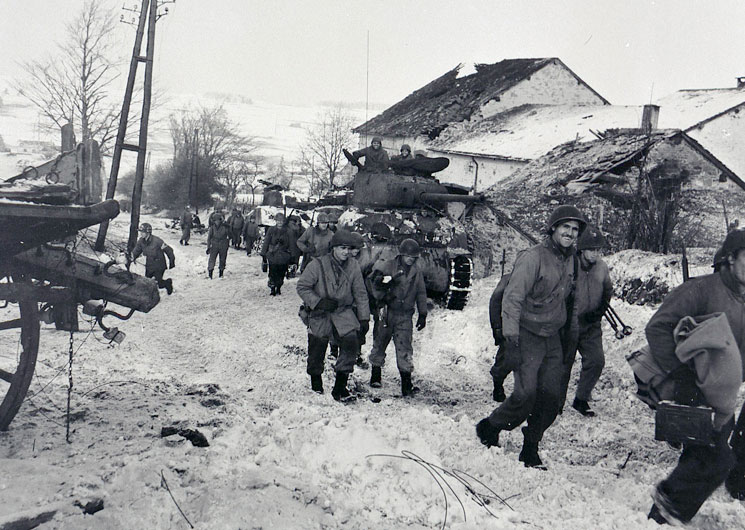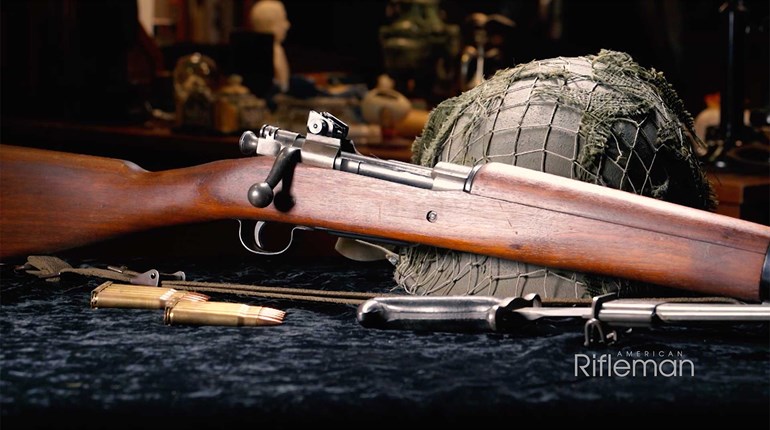
By the time the artillery and rocket barrage began on Dec. 16, 1944, English-speaking German commandos had already infiltrated behind Allied lines, cutting communications, moving signs and securing strategic crossroads to delay U.S. reinforcements. Stretched thin across a 104-mile front, 83,000 GIs, 242 Sherman tanks, 182 tank destroyers and 394 pieces of artillery were all that stood between Hitler and his goal of extending the war by seizing Antwerp and splitting the allied armies.
When 500 German tanks—whose superior armament made them legend—and 200,000 veteran troops rumbled forward, resistance was light. The barrage had been effective, and what little remained of the Allied ability to resist an armored assault fell victim to battle-proven German strategy.
Timed to take advantage of a winter storm that would ground Allied air cover, the attack was designed to get the German forces across the Meuse River, perilously close to the critical supply port of Antwerp. The outcome would be decided on the ground, where Panzer and Panther tanks had a decided advantage over allied Shermans, and U.S. forces were armed with little more than light rifles.
But Hitler grossly underestimated the most critical ingredients of all—American initiative and resolve. This story is about much more than the firearms used to defeat the last major German offensive of World War II. It's about the G.I. spirit, and the undying belief that protecting freedom means fighting for what is right, regardless of the odds.
For a gallery of the guns and men of the Battle of the Bulge, click here.
Springfield '03

The Springfield '03 in its sniper version, designated M1903A4 Sniper, was a variation of the original 1903 rifle produced by Remington during World War II. There were no front or rear sights fitted on the rifle. Instead a Redfield mount was used to attach a Weaver 330C or Redfield Junior scope.

More than 29,000 were of these special bolt-action .30-06 rifles were produced during the war. Ironically, some historians claim that the use of commercial products and failure to hold the sniper versions to a higher-quality standard than regular issue '03s made its performance relatively poor.
It weighed slightly more than nine pounds, had a five-round magazine and a 24-inch barrel that delivered velocities of 2,800 feet per second with ball ammo. Overall length was 43.25 inches. The '03 Sniper was designed as little more than a stopgap measure, while a sniper-version of the M-1 was in development. (See what else Thor Ronningen had to say about his '03 during the Battle of the Bulge)
M-1 Carbine and Rifle

Invented by John C. Garand in the 1920s, the M-1 was originally designed for .276 caliber, although by 1936 engineers had changed it to digest .30-06. At first it didn't receive a particularly warm welcome when introduced to the armed forces, although today its nickname, "Garand," holds a special place in nearly every World War II veteran's heart.
Designed to be easily field stripped, it tipped the scales at a formidable 9.5 pounds, was just under 44 inches long, and had a 24-inch barrel. Springfield Armory and Winchester Repeating Arms Company produced more than 4 million of the rifles by war's end.

Its eight-round, en-bloc clip automatically ejected when empty, and there are numerous anecdotes about that noise giving away a soldier's position and that his rifle was empty. Regardless of the drawbacks, it enabled soldiers to reload quickly and reliably under fire when it counted.
The M-1 Carbine, although often confused with the Garand, featured a completely different design. It too was gas operated, and 15- and 30-round detachable box magazines helped make up for the smaller cartridge. Chambered in .30 Carbine, the carbine had an 18-inch barrel, weighed just more than 5 pounds, and was 35.6 inches long. More than 6 million were produced during the war by some relatively unfamiliar names to the firearms industry: National Postal Meter, IBM, Underwood (of typewriter fame), Saginaw, Rock-Ola (a jukebox manufacturer), Irwin-Pederson, Standard Products, Quality Hardware and of course, Winchester. The original contract for its production even went to General Motors' Inland Manufacturing Division.
The M-1 Carbine was light, reliable, and rarely needed maintenance. My father, Joseph Sagi, who served with the 7th Armored Division, said the moment he arrived in Europe he was instructed by his sergeant to get rid of his rifle's cleaning gear to "save weight." Despite numerous battles, including Arnheim, "It never failed me once," he said. In fact, of the original three platoon members who made it through the Battle of the Bulge, none of them ever experienced a problem with their carbine. Dad was wounded from artillery fire outside St. Vith during the battle, and received the Bronze Star for carrying another wounded G.I. back to U.S. lines.

A few M-1 Carbines were also produced with folding metal stocks for use by U.S. paratroopers, and although extremely rare today, it's reasonable to assume some saw service in the Battle of the Bulge's most famous engagement—Bastogne. There the 101st Airborne had been completely encircled for several days, outnumbered, outgunned and running desperately low on supplies with no hope of re-supply when the German commander sent a message on Dec. 22. It was a request that U.S. forces surrender, and Gen. Anthony McAuliffe's famous one-word response was, "Nuts."
As Gen. George Patton's armored divisions fought their way to relieve the besieged city, one U.S. commander—who would later rise to the rank of general and have the U.S. main battle tank named for him—told his aides, "They've got us surrounded again, poor bastards." Creighton Abrams didn't know it at the time, but it wasn't long until the 101st Airborne would become widely known as the Battered Bastards of Bastogne. By the time of the Battle of the Bulge, the M-1 rifle and carbine were the most common firearms in U.S. inventory. (Read about the field modifications performed by James Clezie to his M-1 before the battle broke out)
Browning Automatic Rifle (BAR)

Chambered in .30-06, the first Browning Automatic Rifle rolled off the assembly line in late 1917. It featured a detachable 20-round box magazine, and depending on variation, weighed between 16 and 20 pounds.
Like most firearms used in World War II, this Browning-designed rifle continued to be modified. The M1918A2 version was fully automatic only, delivering between 300 to 450 rounds per minute when its slow rate of fire was selected, or 500 to 600 in "fast" mode. The earlier M1918A1 was capable of 550 rounds per minute.

This gas-operated design featured a bipod, and a hinged buttplate to maintain proper contact with the operator's shoulder. Because of its high rate of fire, the lack of an interchangeable-barrel provision was considered something of a drawback. During the war BARs were produced by New England Small Arms and IBM, although many were produced before the war by Winchester, Colt and Marlin-Rockwell.
Carrying enough ammunition to feed a BAR could be something of a challenge though. John E. Rames, who was in the 26th Infantry Division, had many of his letters home compiled in a book written by his sister. Titled Traces: A Soldier Writes Home, one passage reflects the lighter side of carrying a BAR. After having drawn ammunition during a training exercise with his BAR, he was running toward a defensive position when he unexpectedly fell down. "But, more determined than ever, I was up in a flash again, started to run, and just as quickly I was down with a crash," he wrote. "This time I realized the trouble. My ammo belt, burdened with the 200 rounds, refused to stay up on my hips and had slid down around my upper legs. Knowing that time was valuable, I quickly pulled it up, grasped the BAR firmly and took off holding the belt up with my left hand and the rifle with my right. Before many steps were taken, the bipods from the rifle spun around and conked me right in the back of my steel helmet, causing me to release my grip on the belt. I grabbed the loose bipod just before the blasted belt slipped again, and down I went with a thud."
Rames was killed during the effort to retake Clervaux during the battle, and a letter from one of his friends in the unit explained, "The Krauts were throwing a lot of artillery and mortars. They scored a direct hit on John's hole and he and another boy were killed instantly, as were a lot of other boys that day. He didn't suffer a bit, as the platoon sergeant went over to John's hole and he was on his way to heaven." Rames is buried in Luxemburg.
(Read the experiences of Jim Graff and Curtis Whitetay behind the BAR during the Battle of the Bulge)
.30-Caliber Machine Guns

It was 1917 when Browning's water-cooled, recoil-operated .30-06 machine gun design was first tested and approved by the U.S. Ordnance Department. By the late 1930s several inadequacies had been remedied, and when the M1917A1 version was introduced—with tripod and water—it weighed more than 90 pounds. Belt fed, it digested 450 to 600 rounds per minute. It was both formidable and weighty in the field.
But a gun that couldn't move handily with a squad during combat was a big drawback, and by the '30s, the M1919A4 was approved by defense officials. Although the air-cooled design was a relatively svelte 45 pounds with tripod, it retained the .30-06 chambering, 24-inch barrel and had identical muzzle velocities. It was, however, 41 inches long, whereas its predecessor was 38.5. The rate of fire was tuned down to 400 to 450 rounds per minute.
Despite the fact the 1919A6 weighed slightly less than 33 pounds, this variant retained a 24-inch barrel. Rate of fire was 400 to 500 rounds per minute and an integral stock and bipod increased its length to 53 inches. Manufacturers of the .30-caliber machine gun variations included: General Motors, Colt, Buffalo Arms, Rock Island Arsenal, Brown-Lipe-Chapman and Saginaw. Nearly 490,000 had been produced by the end of World War II.
In all, more than a million men fought in the Battle of the Bulge: 500,000 Germans, 600,000 Americans (more than at Gettysburg) and 55,000 British troops. Casualties were heavy on all sides: 100,000 Germans, 81,000 Americans and 1,400 British troops. (Take a look at how Max Noe fared behind a .30-caliber machinegun during the battle and read about his Christmas dinner that year)
PostScript

I could fill an entire magazine with the technical details and histories of those weapons used to stop the Nazi advance, but there still wouldn't be enough room. Glaringly absent was any veteran willing to report on the 1911 .45's performance in the sub-zero weather, and one reader wrote to remind me that the fragmentation grenade had every bit as much an impact as any hand-held firearm.
But this story isn't as much about performance, as it is a celebration of the American spirit. It's about jukebox companies willing to put personal interests aside long enough to build the M-1 carbines that sung Hitler's swan song and typewriter manufacturers willing to write the Nazi obit in something other than 12-point Helvetica. It's about the innocent youngsters who served there—willing to face overwhelming odds, in what can only be regarded as the most rigorous field-testing imaginable.
It is, perhaps, a little incomplete in its scope, but judging by the letters we received and tearful phone interviews, the chance to share with America some of what they experienced 60 years ago was long overdue.



































